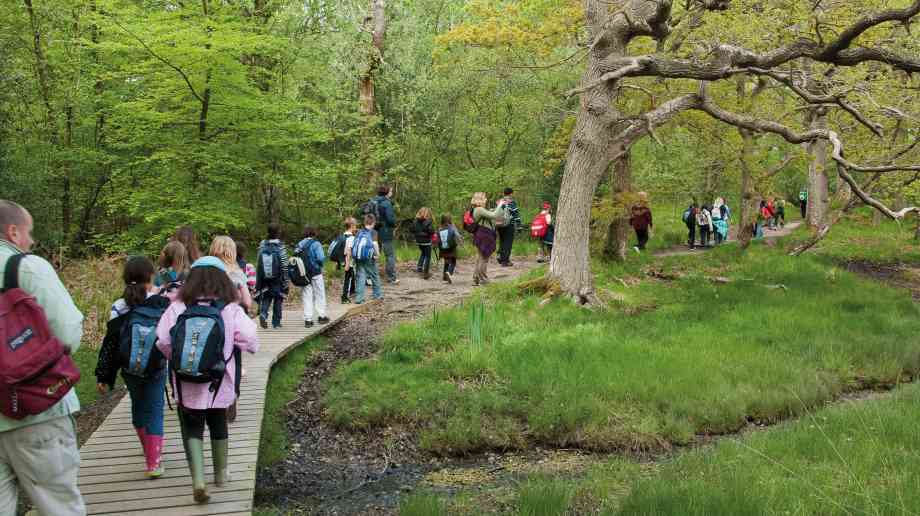
Residential trips: Are they worth it?
Educational trips can broaden students’ horizons. Jane Cooper, of the Countryside Education Trust in the New Forest, regularly witnesses how school trips can connect people with the countryside. Having hosted thousands of school visits over the last 40 years, she shares her experiences.
Take a minute, close your eyes and think: I can almost guarantee you will remember a school trip from your childhood. To the beach, or the mountains, somewhere exotic or just out of sight of home, all of us have such memories. I lived in the East End of London, busy, noisy, dirty and home. The school was very ethnically mixed, and somewhat segregated, but somehow these barriers broke down when we were away from school. Going into the countryside was particularly exciting for inner city kids. I remember flinging myself down a hill with my heart in my mouth, wondering if I would or could stop: I left my sandwiches on the train and my classmates shared their food, much more exotic than mine; and after the trip new friendships remained. That is the point of a school trip in a nutshell, different scenery, new experiences, and better relationships; all catalysts for change.
As a teacher, or a head teacher, residential school trips are undoubtedly a challenge. The responsibility of bringing children into a new environment, not only new to the children but often to the teaching staff as well, can be a significant deterrent and that is before paperwork strikes, with risk assessments, county council requirements, and making sure that the destination itself can meet all the school’s needs, both educational and social.
Parents worry about everything: money, homesickness, separation, whether their children have the right equipment. Heads worry about SATs results. Governors worry about risk. So at the end of it all, why bother?
Real Benefits
The Paul Hamlyn Foundation published its final report in May 2015 into its ‘Learning Away’ experiment, which evidenced what many in the education sector already knew. Both at the secondary and primary level, relationships were improved by the residential experience. In long term follow up at Key Stage 2, for example, 79 per cent of children felt that they knew their teachers better, and 71 per cent claimed that they had better relationships with their peers as a result of the residential.
At secondary the figures were even more impressive, with 80 per cent feeling that relationships both with peers and teachers had improved. In terms of achievement, in both age groups there was an improvement in confidence about exam outcomes, which translated into actual improvements. Staff noticed that this was particularly true for previously low achievers and for boys’ literacy scores. Benefits were not restricted to pupils: staff felt that the residential experience enabled them to develop new pedagogical skills, and that it had impacted on their practice and that of their colleagues.
New Opportunities
Ofsted’s 2015 inspection framework takes into account ‘personal development, behaviour and welfare’. Aspects of all of these can be explored through school trips, to complement the work done in school. Here at Home Farm, for example, the children eat our own meat, harvest vegetables from the garden and collect eggs from our hens.
As a result, every day there are conversations about ethics, fairness, vegetarianism, and religious beliefs about meat which arise naturally because of the environment. Physical and mental well-being is similarly enhanced.
Children have fewer opportunities to be outdoors than their parents enjoyed – 33 per cent of families spend less time outdoors than in the previous generation. Here in the woods, visiting children learn new skills such as map reading and shelter building, they walk between activities, they often get wet and the resilience they learn as a result and the confidence they gain in handling new situations is palpable. Watching birds, lying on the grass looking at the sky, or drawing trees all connect with a more spiritual side. Feeding our livestock or clearing up after dinner depends upon good communication and teamwork.
While school residentials add great value to learning, enabling new approaches for staff and students alike, there are challenges. We see a wide range of schools and over the last forty years we have developed some strong, evidence based thinking about why some visits are more effective than others. Designing a good residential is a matter of being clear early on about the objectives for the students, the staff and the school, and how those can best be met.
Clarity and credentials
It is vital to be clear about the purpose of any residential, so that the right partner organisation can be identified. Create a set of learning objectives and make sure that everyone understands them. In an ideal world, this is not only the teacher planning the trip, but any colleagues coming with the group, the provider and the young people themselves.
Residential trips should offer a real enhancement to curriculum‑based classroom work so that the two are fully integrated. Due diligence is good for everyone. Check the background and qualifications of the providers’ staff as well as insurance documentation and risk assessments. Risk assessments drawn up by providers are more reflective of real risk, as the staff run the same activities multiple times over the course of the year. Utilise that specialist knowledge.
Understanding what skills a residential requires is important. Sometimes, all the specialist support comes from the provider, and all the pastoral work is implemented by the school, but this can vary. A confident staff team can imbue the whole group with a greater sense of resilience and independence; the converse can also be true.
Relationships with the provider
Take advantage of pre-visits. These occasions provide an opportunity to understand site dynamics, to explore potential issues around individuals, to make sure that any special needs are fully accommodated and to start to build a working relationship with the provider. Understanding what can (and can’t) be delivered is constructive in finalising plans.
Research shows that involving students in planning delivers real benefits in learning outcomes. Technology is a great benefit in this regard, as staff can show the students where they will be staying, what it looks like, how each day will run and what the expectations will be in terms of their involvement and behavior during the trips. Even younger participants can help to set the objectives themselves, especially on a social level: for example, in terms of acceptable manners, the use of mobile phones, bedtimes and looking after each other.
Briefing parents
Brief parents early and fully. Make sure they know contact procedures, as carefully managed contact with children makes life better for everyone. Where a parental contribution is requested, ideally offer different payment plans. Supply a kit list but keep it short, as this is often a source of anxiety. And talk about special needs as soon as planning is underway so that, for example, food allergies can be identified.
When it comes to rules, draw up a code of conduct for participants, and involve them. Have a similar code for staff. What is your alcohol policy? And smoking? Make sure that if your partner organisation has guidelines about appropriate outdoor wear, staff abide by them: it is much harder to persuade a 10 year old into waterproofs if a member of staff is wearing shorts.
Leaving young people behind
The Department for Education’s policy is clear: no child should be excluded from an activity simply because his or her parents are unwilling or unable to pay. Especially where a trip will extend classroom curriculum focused work it is really important, and equitable, to ensure high take up. Socially too, it is vital to encompass as many kids possible; 12 per cent of children who have not been able to afford to go on a school residential have been bullied.
Obviously this is one valid use of the Pupil Premium, and subsidies or even funding may be available from providers. Here at the Countryside Education Trust we fund raise ourselves to help schools to try to ensure that cost is not a barrier. All the equipment required is available to our visitors, including water proofs, wellies, tractor suits and backpacks, to obviate additional cost and allay parents’ concerns.
Ensure that there is a mechanism in place for measuring the success of the visit, both educationally and socially, ideally repeated after a few weeks. Use the information in inspections, with governors and prospective parents. Be sure to feedback appropriately to the provider too. We see many schools repeatedly over the years and knowing what has worked well and less well means that we can adjust appropriately to suit our customers.
The words of Michael, one of our young visitors, sums up why all this hard work is worthwhile: “I learned how to milk a goat, it’s more fun than I thought, how to measure different parts of a stream, how to set the table and a lot more. If it wasn’t for you I wouldn’t know half the stuff I know now.”
Further information
www.cet.org.uk
Latest News
27/11/2025 - 11:53
Ofqual has published revised statistics on access arrangements for GCSEs, AS and A levels, alongside new research into the role of time pressure in assessment.
26/11/2025 - 15:22
The announcement follows an earlier pledge of £10 million in funding to provide every primary school in England with a library by 2029.
26/11/2025 - 10:18
The Diets Toolkit recommends that governments introduce more plant-based options in schools, alongside hospitals and other public institutions,
25/11/2025 - 13:05
New data from The Careers & Enterprise Company (CEC) finds that around two-thirds of businesses believe a two-week block of work experience is too time-consuming and offers too little benefit.
25/11/2025 - 12:57
The Youth Sport Trust has launched its latest Class of 2035 Report, warning that unless urgent action is taken to increase physical activity among children, this generation will face poorer health and outcomes.







